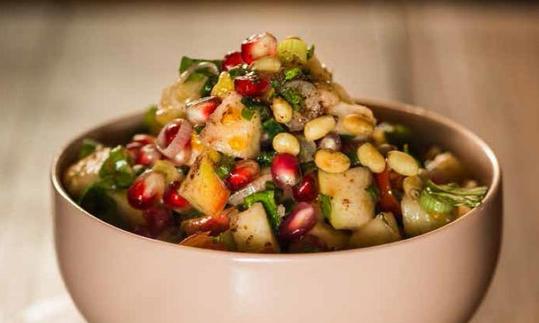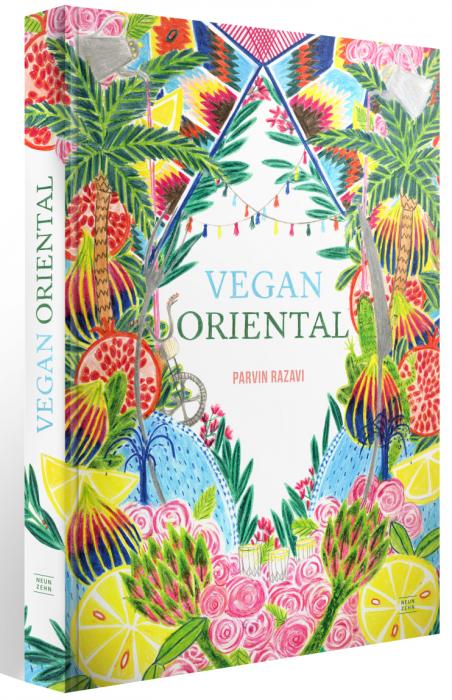Pomegranate and Apple Tabouleh
raw-vegan
Ingredients (for servings, )
| For the vegetable and fruit base | |
|---|---|
| 1 ½ | Apples, raw, with peel (7.9 oz) |
| 2 | Spring / leek / winter onions, raw, organic? (4.1 oz) |
| 1 | Pomegranate (grenadine, raw, organic?) (9.9 oz) |
| For the herb and spice mix | |
| 1 bunch | Peppermint, fresh (raw, organic?) (0.70 oz) |
| 1 bunch | Parsley, fresh, raw (leaf parsley, parsley) (1.1 oz) |
| 1 | Lemons, raw (limes, organic?) (2.0 oz) |
| 1 ½ tsp | Table salt (table salt, raw?, organic?) (0.32 oz) |
| 1 ½ tsp, ground | Black pepper (organic?, raw?) (0.12 oz) |
| ⅔ oz | Pine nuts, raw (seeds, organic?) |
| 1 tsp | Gerber sumac, raw (sumac, organic?) (0.12 oz) |
| 2 tbsp | Olive oil (cold pressed, raw?, organic?) (0.95 oz) |
Equipment
- citrus juicer (lemon squeezer) or juicer
Type of preparation
- food preparation without heating
- squeeze
- season to taste
Preparation
For the vegetable and fruit base
Cut the tart apples (e.g., Topaz apples) into small cubes, removing the seeds, core, and any bad spots. Place in a bowl.If necessary, wash the scallions in running water and then vigorously shake dry. On a cutting board, remove the roots at the base and cut the entire length of the stems into rings. Transfer the rings to the bowl with the apples.
Deseed the pomegranates and then add the seeds to the bowl with the scallions and apples.
Here is an easy way to deseed pomegranates, especially ripe pomegranate. Cut the pomegranate in half horizontally and then use your knife to make cuts in the white part (membranes) in each pomegranate half. Place the pomegranate halves upside down in a bowl and hit the back of each several times with a wooden spoon. The seeds will release from the white membranes and fall out into the bowl.
For the herb and spice mix
Mince the mint using a knife or a mezzaluza and then add to the other ingredients in the bowl.Chop the parsley in the same manner and add to the bowl.
Juice the lemon or lime and pour the juice in the bowl.
Season to taste with sumac, pine nuts (or cedar nuts), salt, and pepper.
Let the flavors meld for 30 minutes and then serve.
If you use dried pine nuts that haven’t been roasted, this tabouleh is a raw dish (unlike the original).
|
Nutritional Information per person
Convert per 100g
|
2000 kcal | |
|---|---|---|
| Energy | 206 kcal | 10.3% |
| Fat/Lipids | 11 g | 16.4% |
| Saturated Fats | 1.4 g | 6.8% |
| Carbohydrates (inc.dietary fiber) | 27 g | 10.1% |
| Sugars | 17 g | 18.6% |
| Fiber | 6.8 g | 27.1% |
| Protein/Albumin | 3.2 g | 6.5% |
| Cooking Salt (Na:885.8 mg) | 2'250 mg | 93.7% |
| Essential micronutrients with the highest proportions | per person | 2000 kcal | |
|---|---|---|---|
| Vit | Vitamin K | 115 µg | 153.0% |
| Sodium, Na | 886 mg | 111.0% | |
| Vit | Vitamin C (ascorbic acid) | 35 mg | 43.0% |
| Min | Manganese, Mn | 0.78 mg | 39.0% |
| Vit | Vitamin B9, B11 (Folate, as the active form of folic acid) | 68 µg | 34.0% |
| Min | Copper, Cu | 0.26 mg | 26.0% |
| Elem | Potassium, K | 438 mg | 22.0% |
| Fat | Linoleic acid; LA; 18:2 omega-6 | 1.9 g | 19.0% |
| Vit | Vitamin E, as a-TEs | 2.2 mg | 18.0% |
| Min | Iron, Fe | 1.9 mg | 14.0% |
Detailed Nutritional Information per Person for this Recipe
The majority of the nutritional information comes from the USDA (US Department of Agriculture). This means that the information for natural products is often incomplete or only given within broader categories, whereas in most cases products made from these have more complete information displayed.
If we take flaxseed, for example, the important essential amino acid ALA (omega-3) is only included in an overarching category whereas for flaxseed oil ALA is listed specifically. In time, we will be able to change this, but it will require a lot of work. An “i” appears behind ingredients that have been adjusted and an explanation appears when you hover over this symbol.
For Erb Muesli, the original calculations resulted in 48 % of the daily requirement of ALA — but with the correction, we see that the muesli actually covers >100 % of the necessary recommendation for the omega-3 fatty acid ALA. Our goal is to eventually be able to compare the nutritional value of our recipes with those that are used in conventional western lifestyles.
| Essential fatty acids | per person | 2000 kcal |
|---|---|---|
| Linoleic acid; LA; 18:2 omega-6 | 1.9 g | 19.0% |
| Alpha-Linolenic acid; ALA; 18:3 omega-3 | 0.09 g | 5.0% |
| Essential amino acids | per person | 2000 kcal |
|---|---|---|
| Tryptophan (Trp, W) | 0.02 g | 7.0% |
| Threonine (Thr, T, irreversibly transaminated) | 0.06 g | 7.0% |
| Isoleucine (Ile, I) | 0.07 g | 6.0% |
| Valin (Val, V) | 0.09 g | 6.0% |
| Leucine (Leu, L) | 0.13 g | 5.0% |
| Lysine (Lys, K, irreversibly transaminated) | 0.08 g | 5.0% |
| Phenylalanine (Phe, F) | 0.07 g | 5.0% |
| Methionine (Met, M) | 0.03 g | 3.0% |
| Vitamins | per person | 2000 kcal |
|---|---|---|
| Vitamin K | 115 µg | 153.0% |
| Vitamin C (ascorbic acid) | 35 mg | 43.0% |
| Vitamin B9, B11 (Folate, as the active form of folic acid) | 68 µg | 34.0% |
| Vitamin E, as a-TEs | 2.2 mg | 18.0% |
| Vitamin B1 (Thiamine) | 0.11 mg | 10.0% |
| Vitamin B6 (pyridoxine) | 0.13 mg | 9.0% |
| Vitamin B2 (Riboflavin) | 0.11 mg | 8.0% |
| Vitamin B5 (Pantothenic acid) | 0.42 mg | 7.0% |
| Vitamin A, as RAE | 59 µg | 7.0% |
| Vitamin B7 (Biotin, ex vitamin H) | 3.4 µg | 7.0% |
| Vitamin B3 (Niacin) | 0.84 mg | 5.0% |
| Essential macroelements (macronutrients) | per person | 2000 kcal |
|---|---|---|
| Sodium, Na | 886 mg | 111.0% |
| Potassium, K | 438 mg | 22.0% |
| Phosphorus, P | 83 mg | 12.0% |
| Magnesium, Mg | 40 mg | 11.0% |
| Calcium, Ca | 63 mg | 8.0% |
| Essential trace elements (micronutrients) | per person | 2000 kcal |
|---|---|---|
| Manganese, Mn | 0.78 mg | 39.0% |
| Copper, Cu | 0.26 mg | 26.0% |
| Iron, Fe | 1.9 mg | 14.0% |
| Zinc, Zn | 0.86 mg | 9.0% |
| Selenium, Se | 0.67 µg | 1.0% |
| Iod, I (Jod, J) | 0.93 µg | 1.0% |
| Fluorine, F | 2.2 µg | < 0.1% |
The book "Vegan Oriental" introduces us to exotic, uncomplicated recipes. Parvin Razavi's credo: conscious, sustainable nutrition.
Since this book is written in German, a description is omitted here. If you are interested, please switch to German in the menu.
Pomegranate and apple tabouleh (tabouli) is a hearty fruit salad that contains herbs and pine nuts and can be prepared raw.
Sumac: Sumac is a typical Arabic or oriental spice and is actually called Sicilian sumac, tanner’s sumach, or elm-leaved sumach. The spice is dried and usually sold in ground form.
The tart dark red spice is often mixed with salt and is particularly popular in Turkish, Arabic, Kurdish, and Persian cuisine.
However, high-quality sumac does not contain any salt and the fruit is sold in whole form so that the bitter substances haven’t been released. The clusters of berries are dried, and then the berries are separated from the seeds.
Purchasing sumac: You can find tanner’s sumac in Turkish and Middle Eastern grocery stores.
Amount of oil: The original recipe calls for three tablespoons oil, but we have only used two. According to many researchers, the Western diet contains too much oil.
Reducing salt: It is worthwhile to reduce the amount of salt you consume. A total of 2.5 g table salt per day (1 g sodium) would be the ideal intake, especially if high blood pressure is an issue.
Pure table salt is considered to be lethal to adults at a dose of 10 tablespoons. See the link to salt in the ingredients list. In this recipe, you should start with a lot less salt than is called for and then season to taste, adding only as much as is needed.
Tabouleh as a raw dish: In order to be able to make this tabouleh dish raw, we use dried pine nuts that haven’t been roasted. The original dish has a parsley and bulgur (or couscous) base and usually contains tomatoes, scallions or shallots, olive oil, water, and lemon juice. It is seasoned with fresh peppermint and salt and pepper. However, the original recipe isn’t raw as the tomatoes are scalded and bulgur is a processed, parboiled wheat.




